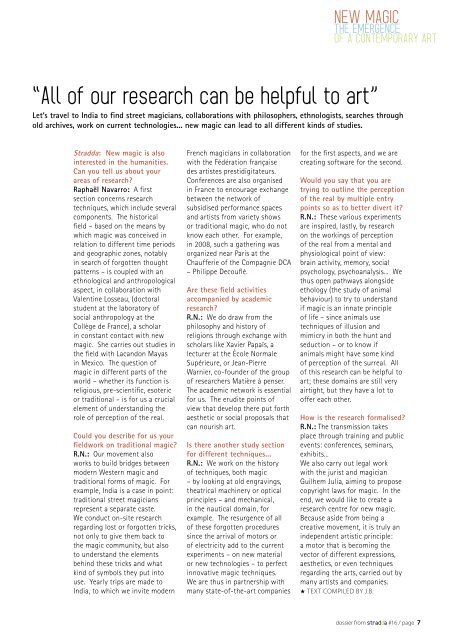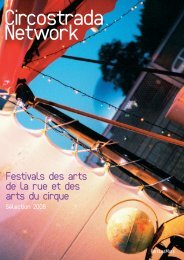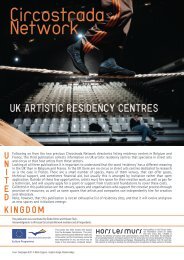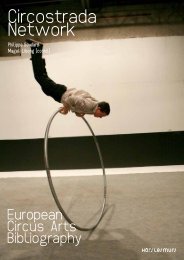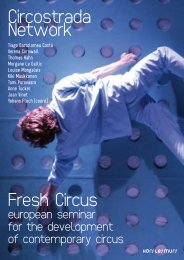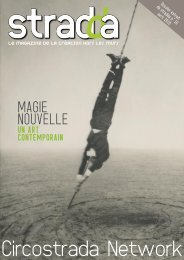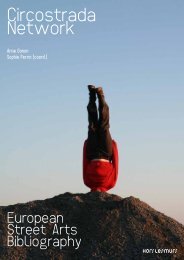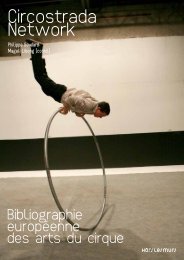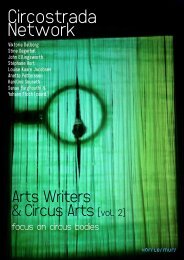MAGIE NOUVELLE - Circostrada Network
MAGIE NOUVELLE - Circostrada Network
MAGIE NOUVELLE - Circostrada Network
Create successful ePaper yourself
Turn your PDF publications into a flip-book with our unique Google optimized e-Paper software.
NEW MAGIC<br />
THE EMERGENCE<br />
OF A CONTEMPORARY ART<br />
“All of our research can be helpful to art”<br />
Let’s travel to India to find street magicians, collaborations with philosophers, ethnologists, searches through<br />
old archives, work on current technologies... new magic can lead to all different kinds of studies.<br />
Stradda: New magic is also<br />
interested in the humanities.<br />
Can you tell us about your<br />
areas of research<br />
Raphaël Navarro: A first<br />
section concerns research<br />
techniques, which include several<br />
components. The historical<br />
field – based on the means by<br />
which magic was conceived in<br />
relation to different time periods<br />
and geographic zones, notably<br />
in search of forgotten thought<br />
patterns – is coupled with an<br />
ethnological and anthropological<br />
aspect, in collaboration with<br />
Valentine Losseau, (doctoral<br />
student at the laboratory of<br />
social anthropology at the<br />
Collège de France), a scholar<br />
in constant contact with new<br />
magic. She carries out studies in<br />
the field with Lacandon Mayas<br />
in Mexico. The question of<br />
magic in different parts of the<br />
world – whether its function is<br />
religious, pre-scientific, esoteric<br />
or traditional – is for us a crucial<br />
element of understanding the<br />
role of perception of the real.<br />
Could you describe for us your<br />
fieldwork on traditional magic<br />
R.N.: Our movement also<br />
works to build bridges between<br />
modern Western magic and<br />
traditional forms of magic. For<br />
example, India is a case in point:<br />
traditional street magicians<br />
represent a separate caste.<br />
We conduct on-site research<br />
regarding lost or forgotten tricks,<br />
not only to give them back to<br />
the magic community, but also<br />
to understand the elements<br />
behind these tricks and what<br />
kind of symbols they put into<br />
use. Yearly trips are made to<br />
India, to which we invite modern<br />
French magicians in collaboration<br />
with the Fédération française<br />
des artistes prestidigitateurs.<br />
Conferences are also organised<br />
in France to encourage exchange<br />
between the network of<br />
subsidised performance spaces<br />
and artists from variety shows<br />
or traditional magic, who do not<br />
know each other. For example,<br />
in 2008, such a gathering was<br />
organized near Paris at the<br />
Chaufferie of the Compagnie DCA<br />
– Philippe Decouflé.<br />
Are these field activities<br />
accompanied by academic<br />
research<br />
R.N.: We do draw from the<br />
philosophy and history of<br />
religions through exchange with<br />
scholars like Xavier Papaïs, a<br />
lecturer at the École Normale<br />
Supérieure, or Jean-Pierre<br />
Warnier, co-founder of the group<br />
of researchers Matière à penser.<br />
The academic network is essential<br />
for us. The erudite points of<br />
view that develop there put forth<br />
aesthetic or social proposals that<br />
can nourish art.<br />
Is there another study section<br />
for different techniques...<br />
R.N.: We work on the history<br />
of techniques, both magic<br />
– by looking at old engravings,<br />
theatrical machinery or optical<br />
principles – and mechanical,<br />
in the nautical domain, for<br />
example. The resurgence of all<br />
of these forgotten procedures<br />
since the arrival of motors or<br />
of electricity add to the current<br />
experiments – on new material<br />
or new technologies – to perfect<br />
innovative magic techniques.<br />
We are thus in partnership with<br />
many state-of-the-art companies<br />
for the first aspects, and we are<br />
creating software for the second.<br />
Would you say that you are<br />
trying to outline the perception<br />
of the real by multiple entry<br />
points so as to better divert it<br />
R.N.: These various experiments<br />
are inspired, lastly, by research<br />
on the workings of perception<br />
of the real from a mental and<br />
physiological point of view:<br />
brain activity, memory, social<br />
psychology, psychoanalysis... We<br />
thus open pathways alongside<br />
ethology (the study of animal<br />
behaviour) to try to understand<br />
if magic is an innate principle<br />
of life – since animals use<br />
techniques of illusion and<br />
mimicry in both the hunt and<br />
seduction – or to know if<br />
animals might have some kind<br />
of perception of the surreal. All<br />
of this research can be helpful to<br />
art; these domains are still very<br />
airtight, but they have a lot to<br />
offer each other.<br />
How is the research formalised<br />
R.N.: The transmission takes<br />
place through training and public<br />
events: conferences, seminars,<br />
exhibits...<br />
We also carry out legal work<br />
with the jurist and magician<br />
Guilhem Julia, aiming to propose<br />
copyright laws for magic. In the<br />
end, we would like to create a<br />
research centre for new magic.<br />
Because aside from being a<br />
creative movement, it is truly an<br />
independent artistic principle:<br />
a motor that is becoming the<br />
vector of different expressions,<br />
aesthetics, or even techniques<br />
regarding the arts, carried out by<br />
many artists and companies.<br />
★ TEXT COMPILED BY J.B.<br />
dossier from stradda #16 / page 7


